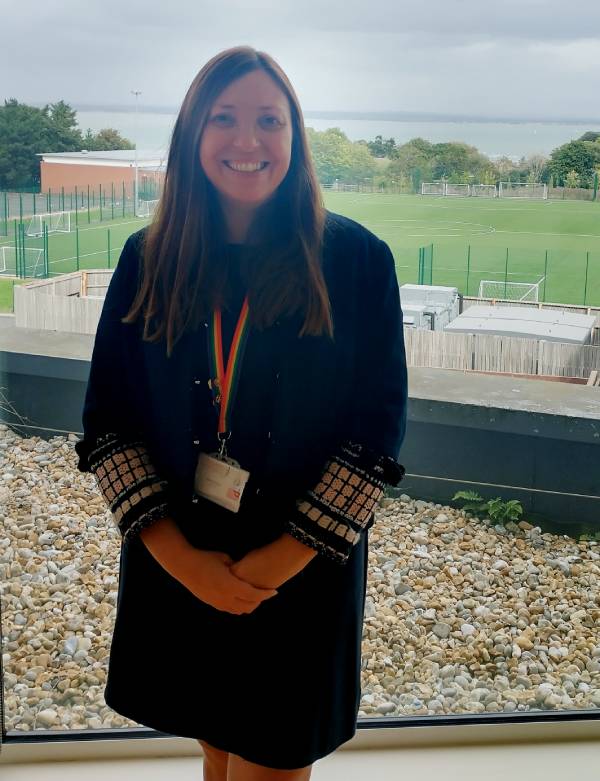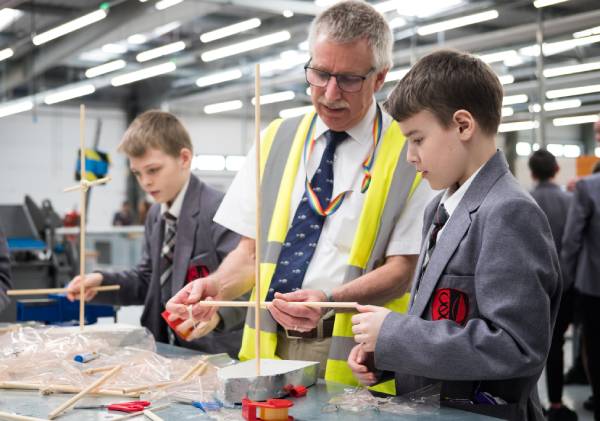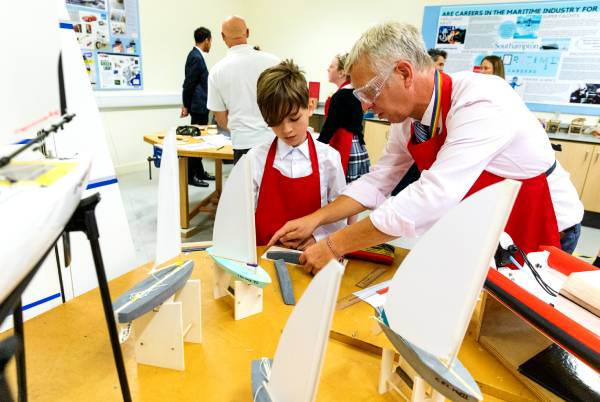- Topics
- Campaigning
- Careers
- Colleges
- Community
- Education and training
- Environment
- Equality
- Federation
- General secretary message
- Government
- Health and safety
- History
- Industrial
- International
- Law
- Members at work
- Nautilus news
- Nautilus partnerships
- Netherlands
- Open days
- Opinion
- Organising
- Podcasts from Nautilus
- Sponsored content
- Switzerland
- Technology
- Ukraine
- United Kingdom
- Welfare

The UK maritime sector is struggling to attract new recruits, while children in coastal communities are often unaware of the opportunities available to them. Rob Coston reports on a remarkable project that has helped to reinvigorate a struggling secondary school by putting the industry at the heart of learning
Something very special is happening at Cowes Enterprise College (CEC) on the Isle of Wight – and it could soon be coming to a school near you. The secondary school is pioneering a maritime education project that could help to solve the shortage of people joining the industry, while also boosting the UK's neglected coastal communities.
Community pride
While often thought of as a prosperous holiday destination, the Isle of Wight actually has a slew of problems common to UK coastal communities. A 2017 report by the Social Market Foundation found that these areas are among the worst-ranked parts of the UK across a range of economic and social indicators, including earnings, employment, health and education.
The island suffers from 'brain drain', with a lack of appreciation for the area meaning that many talented young people choose to leave when they get the opportunity, while other students give up and have historically ended up unemployed – all while the island's maritime industry struggles to fill a wide range of good jobs.
Cowes Enterprise College is a 1,200-pupil secondary school and sixth form, serving a community in the island's main port. In 2013 it was put into special measures, with Ofsted identifying problems such as poor exam results, variable/inadequate teaching quality, poor progress, and unchallenging lessons that failed to interest students. The report said that 'there are also weaknesses in the curriculum (the way in which the school organises the subjects that students study).'
Now out of special measures, the school appears to be thriving – and a key part of turning things around is the Maritime Futures Curriculum put in place by principal Rachel Kitley.
Why maritime?

Ms Kitley joined the school in 2017, at which point the school had run through nearly a dozen previous heads in just seven years. Coming from an inner-city school in London, she quickly realised that the techniques she had applied there could not be used to improve the quality of education at Cowes. The key problem was a lack of aspiration, so something very different was needed – and maritime offered an answer.
She stresses that improving education could not be done in isolation from wider social issues on the island: 'I was very shocked to discover students didn't understand the fantastic maritime possibilities available to them, and unfortunately a lot of them were being lost to unemployment.' Other students were, for example, taking up careers in engineering without understanding that they could apply their skills in maritime.
The solution was to 'anchor our children in their local environment,' she says.
What's in the curriculum?
The school's Maritime Futures Curriculum covers Key Stage 3 – the pre-GCSE lessons taught to 11-14 year olds – but it does not seek to replace the UK national curriculum. Instead, subjects are taught according to the normal curriculum but with maritime as a 'golden thread' woven through various subjects; for example, 16% of Design and Technology lessons across Key Stage 3 are maritime-related. It is also at the heart of the science curriculum – included in 12% of lessons – as many career links can be made.
For example, if students are studying forces in physics, they will look at fluid dynamics. Maritime ecosystems are included in biology lessons, and navigational principles in maths. In geography, our globalised world is explored through the lens of maritime issues such as the impact of containerisation and the growth of offshore wind energy.
The humanities are included too. 'Nobody is forced to sing sea shanties in music or learn The Rime of the Ancient Mariner,' vice principal Tom Harding explains – maritime is only added where useful and appropriate. But in art, for example, students look at maritime paintings and consider how these feed into our understanding of ourselves as a nation. To counter the sense that the Isle of Wight is a 'dead end' place, the island's maritime past is emphasised, and for history, students cross to a museum in nearby Portsmouth to visit Henry VIII's flagship Mary Rose, the sinking of which would have been visible from the school site.

'Our curriculum is not driven by textbooks, but by our students' interests and the world around them,' says Kelly Wiltshire, head of geography, who takes her students on a boat trip around the island when studying coastal erosion.
The 'maritime' in the curriculum is broadly defined, incorporating industry body Maritime UK's five areas of 'shipping, ports, marine (leisure, shipbuilding, technology and science) and maritime business services'. Lessons feature the area's rich heritage, while placing demanding academic concepts and techniques into 'real life' settings via close ties with the local maritime industry – and the current leading-edge work being done by companies on the island is mentioned where possible.
Taken together, this approach introduces the idea of a maritime career to students before they begin making choices about their future and ruling things out – solving a problem identified by colleges in the Nautilus Telegraph's special reports on education in March/April 2022. It also signposts them to different roles in the maritime industry, from welder or traditional boatbuilder to Merchant Navy cadet or scientist, so that students of all academic abilities and a range of different interests are covered. The maritime curriculum ties into an extensive careers advice service, which includes visits from maritime professionals. In 2021, the school achieved the Quality in Careers Standard', awarded by a consortium of UK education bodies for dedication to providing students with valuable career engagement opportunities.
Our maritime curriculum is not driven by textbooks, but by our students' interests and the world around them Kelly Wiltshire, head of geography
Good for students?
The results show that the curriculum is good for students, not just the industry.
When the school introduced Maritime Futures it was first given to trial groups, so that results could be compared with students on the traditional curriculum. This showed that in Year 7 (ages 11-12) assessment scores were 19% higher for students using Maritime Futures, and in Year 8 (ages 12-13) they were up 11%.
Better motivation is also evident, and the new curriculum has closed the significant gap between disadvantaged students and their peers, both in terms of engagement and results. In 2018-19, 21.5% of non-disadvantaged students were rated as particularly enthusiastic about learning and 10% of disadvantaged students. After the full introduction of Maritime Futures in 2019-20 this had increased to 37% and 35.4% respectively.
67% of Year 9 students polled (ages 13-14) said they would consider studying a maritime qualification in Year 10, the usual year for starting GCSEs. It's no surprise that the school has since won the prestigious Maritime UK Award for Future Skills for its work putting the curriculum in place.
A school near you
Following these results, Cowes is encouraging other schools to adopt the model, but always in a way that is relevant to their local circumstances. The rollout is possible because Maritime Futures works within the national curriculum rather than seeking to replace it – schools are unlikely to teach niche qualifications that are not measured on league tables.
Ormiston Trust, which manages the school, has taken on a former teacher with a long career in maritime, Alan Hillman, to promote the scheme's uptake. He taught at the predecessor school, but actually left the profession after his experiences – and so he was 'blown away' on a visit to the relaunched school and amazed at the progress made by students. 'This is a model that needs to be spread, not necessarily owned,' he says.

The curriculum will be rolled out in partnership schools – five already in the first tranche, three so far in the second – with talks ongoing to bring others in. The partner and target schools are across the whole of the UK, from the Scottish isles to London. One school, in the seaside town of Great Yarmouth, Norfolk, will begin using the Maritime Future Curriculum in the summer term of 2023. These schools will be supported with two-day conferences each term and a package of help for those that adopt it, including the ability to sit in for lessons, workshops for head teachers on how to embed change (as they create the budget and culture), advice on what to do in the local area at a curriculum level to make learning relevant for students, and practical subject-level advice for heads of department on how to bring maritime into lessons.
What these schools teach though – and the maritime businesses they bring in – will potentially be very different from on the Isle of Wight. Schools in Hull and Grimsby, for example, are likely to give more prominence to the offshore wind sector – reflecting local opportunities – and focus on different areas of maritime history to highlight their own past.
'We have the experience to help them develop what will work within their local context,' says Mr Hillman.
- Find out more about the curriculum
Tags
More articles
Want to work in P&I? Find out more at Nautilus Sea to City webinar
Registration is now open for Nautilus International's third Sea to City webinar on maritime insurance.
Nautilus podcast Off course: Episode 1 – piracy featuring Captain Rich Phillips
As part of its campaign against sea-blindness, Nautilus launched a new podcast series Off course: A sideways look at life at sea, and spoke to a master who inspired a movie about piracy.
